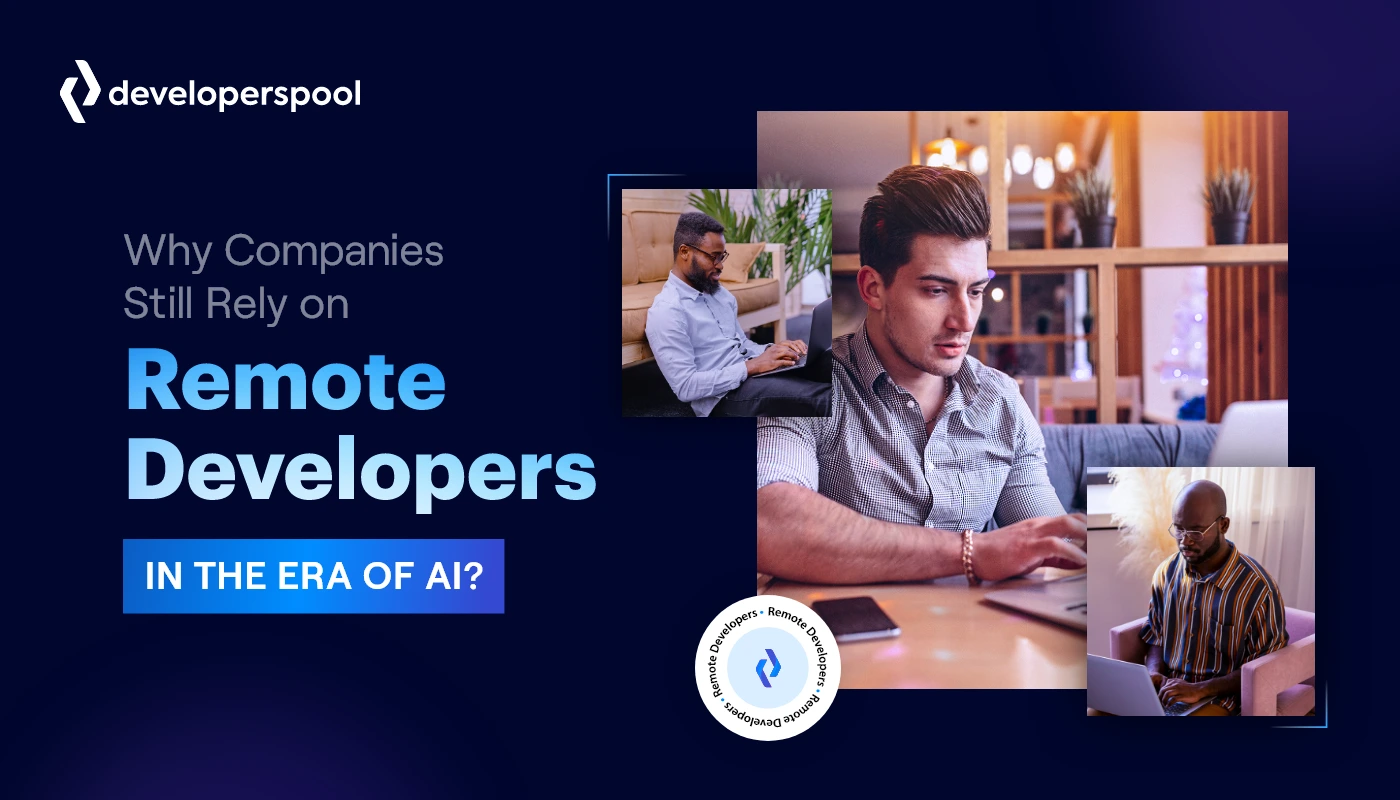2025 Developer Shortage: Why Offshore Hiring Is the Only Scalable Fix
- November 6, 2025
- 8 mins
- 1.4k

In 2025, technology isn’t just “supporting the business.” It is the business. From AI and automation to cloud modernization and cybersecurity, enterprise transformation is accelerating. Yet there’s a hard truth: the world is running out of skilled developers.
Despite aggressive digital spending, companies continue to struggle to hire software developers at scale. According to latest surveys 75% of organizations will experience chronic IT skills shortages throughout 2025.
As organizations aim to expand software teams rapidly, traditional developer recruitment models are falling short. The challenge isn’t just quantity. It’s securing the right technical expertise at the right time-without overspending or compromising delivery.
Offshore hiring, once seen as a cost-efficiency play, has now become a strategic scalability engine.
The Skill Crunch: Why the Talent Gap Is Getting Worse
Global demand for technical skills has outpaced supply for years, but four shifts have intensified the crisis:
1️. AI Adoption Is Creating New Talent Requirements
Businesses are no longer looking for just full-stack developers-they need AI development, data engineering, DevOps automation & cloud-native expertise. Companies unable to hire AI developers risk falling behind automation-driven competitors.
2️. Workforce Demographics Are Reshaping Tech Labor Pools
The U.S. and Europe are facing aging tech workforces and reduced enrollment in computer science programs. Adding pressure, global high-performers increasingly prefer remote or flexible work-making offshore talent more accessible and attractive.
3️. Wage Inflation Is Impacting Talent Retention
Hiring locally often comes with 40–70% higher compensation costs. Add in turnover and reskilling investments & software engineer staffing becomes unsustainable for smaller digital teams.
4️. Innovation Cycles Are Shorter Than Recruitment Cycles
Product roadmaps and transformation programs require agility. But the average time to hire a software programmer (from sourcing to onboarding) has surpassed 63 days. Business velocity can’t wait.
Conclusion: The crisis is no longer cyclical. It’s structural. Organizations need new operating models to build and scale technology capacity.
Why Offshore Hiring Is the Only Scalable Fix for 2025?
Forward-looking enterprises are shifting to offshore and nearshore models because they enable elastic talent expansion without slowing delivery or breaking budgets.
Here’s what makes offshore hiring unstoppable in 2025:
Access to Untapped Global Talent Pools
Countries like India, Vietnam, the Philippines & Eastern Europe are producing large numbers of certified software developers fluent in global enterprise technologies.
Organizations can now hire software developer teams with specialized capabilities in:
- Cloud engineering (AWS, Azure, GCP)
- AI & machine learning
- Data analytics & data pipelines
- Cybersecurity & DevSecOps
- Mobile development (iOS & roid, cross-platform)
- Modern enterprise systems (SAP, Salesforce, Microsoft stack)
Instead of competing locally against Big Tech, enterprises expand their options to the best place to hire developers globally.
Cost Efficiency with Higher Value Density
Offshore hiring isn’t just about reduced salaries. It’s about maximizing productive engineering time per dollar.
Cost advantages come from:
- Labor arbitrage in emerging tech economies
- Shared delivery models
- Optimized staffing ratios
- Follow-the-sun workflows reducing downtime
By collaborating with the right technical staffing agency or offshore partner, organizations redirect cost savings to innovation, automation & new product investments.
Faster Hiring and Rapid Team Expansion
Time-to-hire shrinks from months to weeks-or even days-when companies leverage pre-vetted offshore teams.
Flexible models enable:
- Quick ability to find app developers for short-term projects
- Rapid hiring for transformative initiatives
- Capacity adjustment based on demand
- Parallel multi-team development streams
When speed decides market leadership, developer recruitment must support scale, not constrain it.
24/7 Development Velocity
Distributed delivery unlocks continuous productivity. While one region sleeps, another writes code, conducts QA & optimizes deployments.
This enables:
- Faster release cycles
- Better incident resolution time
- Round-the-clock innovation
Businesses gain a follow-the-sun advantage that internal-only teams simply can’t match.
What Strong Offshore Models Deliver That Local Hiring Can’t
| Capability | In-House / Local Only | Offshore-Enabled Model |
| Talent availability | Limited pool, high competition | Global supply with niche expertise |
| Time-to-hire | Long (6–12 weeks) | Fast (1–3 weeks) |
| Cost flexibility | High fixed cost structure | Variable, scalable cost model |
| Delivery hours | 9–5 efficiency | 24/7 progress |
| Tech coverage | Dependent on local market | Deep & diversified global skills |
Offshoring has evolved from cost arbitrage into strategic digital workforce transformation.
Where Offshore Talent Adds the Highest Business Value
Organizations leveraging offshore delivery see strong outcomes in:
Product Engineering – Accelerating new digital services and revenue streams
Modernization & Cloud Migration – Scaling transformation at high velocity
AI & Automation Projects – Filling critical roles where local AI developers are scarce
Enterprise Application Management – Sustaining uptime with shared support models
Cybersecurity & Compliance Support – 24/7 monitoring and rapid incident response
Whenever workload spikes or specialized skills are required, offshore teams close the gap instantly.
A New Standard: Hybrid Talent & Workforce Orchestration
The most successful enterprises aren’t choosing between local or offshore-they’re rebalancing toward global workforce orchestration:
- Core architecture and leadership remain in-house
- Offshore delivery teams become the scalability layer
- Specialists plug in through information technology consultants
- Governance ensures security, compliance & knowledge continuity
This is how organizations move from resourcing challenges to talent abundance.
Quality and Security Concerns: Myth vs Reality
Historically, offshoring faced credibility challenges. Today, delivery ecosystems are engineered for compliance:
- ISO-certified development centers
- Zero-trust security architectures
- Automated CI/CD pipelines for quality enforcement
- Clear SLAs and engineering governance
- IP protection agreements aligned with global standards
- Agile collaboration tools ensuring transparency
Modern offshore partners bring maturity, accountability & outcome-focused delivery-not just staffing bodies to fill seats.
Picking the Right Offshore Partner: What Enterprises Must Evaluate
To maximize offshore success, businesses must focus on:
- Technical depth: Can they cover emerging tech and AI use cases?
- Talent scalability: Can they ramp teams by 20–50 engineers at short notice?
- Process excellence: Do they operate full-agile with automation?
- Cultural alignment: Are communication and collaboration seamless?
- Industry understanding: Do they have proven vertical expertise?
- Pricing transparency: No hidden cost surprises
The difference between offshore success and failure depends on choosing capability, not just cost.
Strategic Outcomes Delivered by Offshore Hiring
Companies unlocking global delivery models report:
- 30–50% lower development costs
- 2–3x faster delivery cycles
- Global skills access without location limits
- Improved resilience in hiring disruptions
- Ability to scale peak demand and shrink downtime
These improvements reshape market competitiveness, especially when transformation is continuous.
The Bottom Line: Offshore Isn’t Optional Anymore
The developer shortage will not resolve itself through local hiring. The competitive advantage now lies with organizations that design global talent strategies focused on:
- Cost-efficient expansion
- Rapid innovation
- Global skills coverage
- Delivery sustainability
To hire developers at scale-and to keep delivering new digital value-offshore hiring is the only model that matches modern business dynamics.
Enterprises that move first gain the innovation edge. Those who postpone face stalled pipelines, rising costs & widening technology gaps.
2025 belongs to the organizations that build globally and ship continuously.
Final Thought
Software is shaping every industry. But software doesn’t build itself. Top enterprises are embracing offshore models not as a workaround but as a catalyst for digital acceleration, resilience & sustainable innovation If talent is the fuel for growth, global developer access is the engine.
Frequently Asked Questions
Offshore teams allow parallel development cycles, including nighttime delivery continuity, which shortens release timelines significantly. When U.S./Europe teams log off, offshore squads continue sprint execution -bugs get resolved faster & product iteration never pauses. This eliminates the delivery bottlenecks that local-only hiring models create.
Absolutely. India, Eastern Europe & LATAM have strong talent pools in machine learning, LLM implementation, MLOps, data engineering & cloud-native architectures. Many organizations now offshore not only execution tasks but also innovation roles such as Generative AI integration, model evaluation & predictive feature engineering.
Risks like communication gaps, IP security, or inconsistent delivery are drastically reduced when partnering with an experienced technical staffing agency. Best-practice frameworks include NDA protections, secure work environments, agile reporting, daily standups & outcome-based performance KPIs aligned to product success.
Instead of waiting 3–6 months for a single local hire, dedicated offshore teams are typically staffed in 2–4 weeks. Pre-vetted talent pipelines across skill categories allow rapid matching, faster onboarding & measured productivity from Sprint 1 -not months later.
Not when structured correctly. Modern offshore delivery operates with shared ownership, agile collaboration tools, continuous integration pipelines & transparent delivery metrics. Offshore professionals become embedded team members -participating in planning, demos, retros & architecture discussions just like in-house engineers.
Recent Blogs
Stay ahead with the latest tech trends with our informative blogs and
insider guide to hire the best talent.






